| 1 | A Brazilian tree snake |
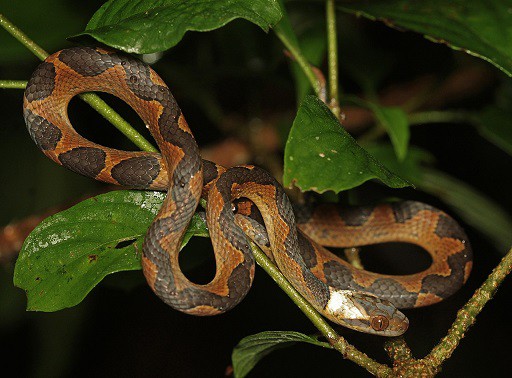
Boa constrictors are found in virtually every corner of South America (except Chile), and everyone has heard of them. A lesser known snake which is incredibly common is the annulated cat-eyed snake (Leptodeira annulata), a humble tree snake which has never killed a human, and averages at 90-110cm.
This species has a mild venom which causes swelling, but little else. It’s a tree snake which spends the majority of the day on branches, leaping between them nimbly, helped by a thin body. It’s named for its eyes, which not only have vertical slits for pupils like a cat, but are large and bulbous like a crystal ball. Leptodeira annulata has such bulging eyes that the outline is visible in silhouette form.
This is a highly variable snake in appearance. They vary from plain orange, to grey with brown blotches, to black and deep orange like a tiger. Leptodeira annulata had a very confusing family tree, and some subspecies, like L. annulata ashmeadi from Venezuela, have been elevated to full species. But Leptodeira annulata is still extremely common. It covers virtually all of Brazil, the northern countries like Colombia, Suriname, and Guyana, and reaches central Argentina. Their favourite habitats are tree clumps near a water body, like ponds, lakes and marshes. This allows them to access their main prey: frogs. Leptodeira annulata is most frequently sighted during rainy season, when it gorges on the abundance of hopping frogs to its heart’s content.
| 2 | Freaky abilities |
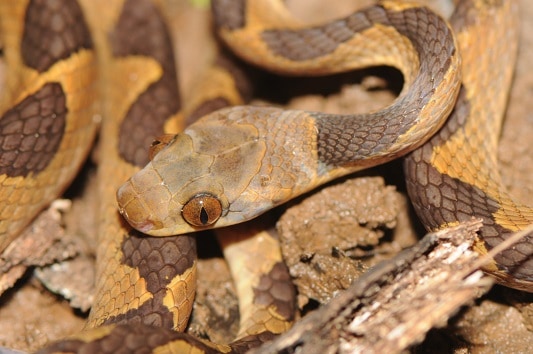
Living in trees near wetlands gives Leptodeira annulata many unique opportunities, and one unusual skill is snatching the eggs of amphibians. The red-eyed treefrog is a species which lays its eggs in trees, while its tadpoles spend their days in aquatic environments. Leptodeira annulata is proven to seek out these egg stashes and rip great gooey chunks off them. A few other snakes do this – parrot snakes and northern cat-eyed snakes – but for the most part it’s a unique food source, with little competition from fellow snakes.
It turns out that red-eyed tree frogs are actually attuned to the snake’s attacks, before they’re officially born. If the eggs sense the oncoming vibrations of an annulated treesnake, they will hatch prematurely, and drop from the tree into the safety of ponds. When benign, non-predator vibrations were tested, none of the eggs hatched. The eggs are able to measure duration and spacing of vibrations, and match them to long-standing predators in their evolutionary databanks.
This study found that on average, the frogspawn began hatching 16 seconds after the snakes (which included L. annulata) began their attacks. Some didn’t hatch until 1 minute later. Through a combination of tadpoles fleeing and snakes gobbling up the goo, the entire frog spawn was usually gone within 5 minutes.
| 3 | Hard to predict |
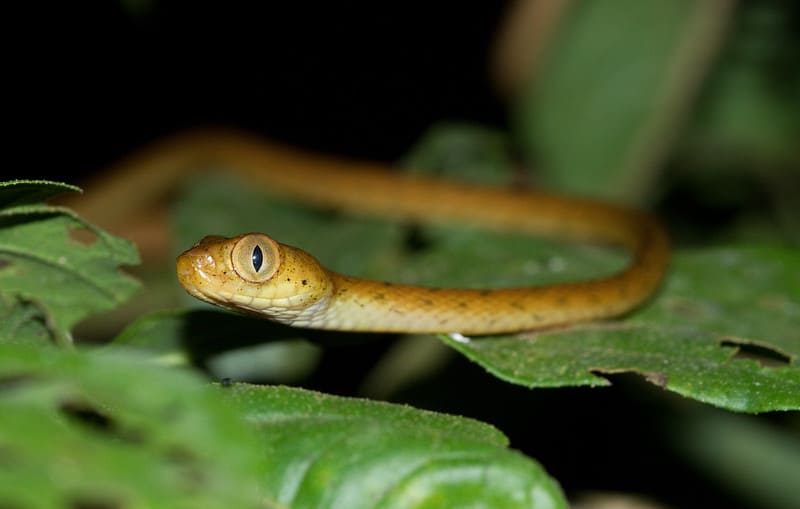
While excellent tree climbers, Leptodeira annulate stay relatively close to the ground. In one study, their average height was 1.65 metres above ground. The average trunk diameter in the trees they inhabited was 80cm.
This species has a large repertoire of defensive strategies it can deploy at will. Leptodeira annulata will raise its upper body, and shift bones in order to triangulate its head, mimicking a viper. They’ll release a vile snake smell that forces anyone in the vicinity to flee, to protect their precious nose. If touched while on a branch, then Leptodeira annulata will instantly drop to the ground, in a leap of faith. The last is good old fashioned escape, and Leptodeira annulata can flee at high speeds when pressured.
The last weapon in their arsenal is venom. Annulated cat-eyed snakes don’t come close to a common lancehead or bushmaster, but they have a moderately intense venom capable of deforming a human’s body parts.
| 4 | Capable of inflating your hand |
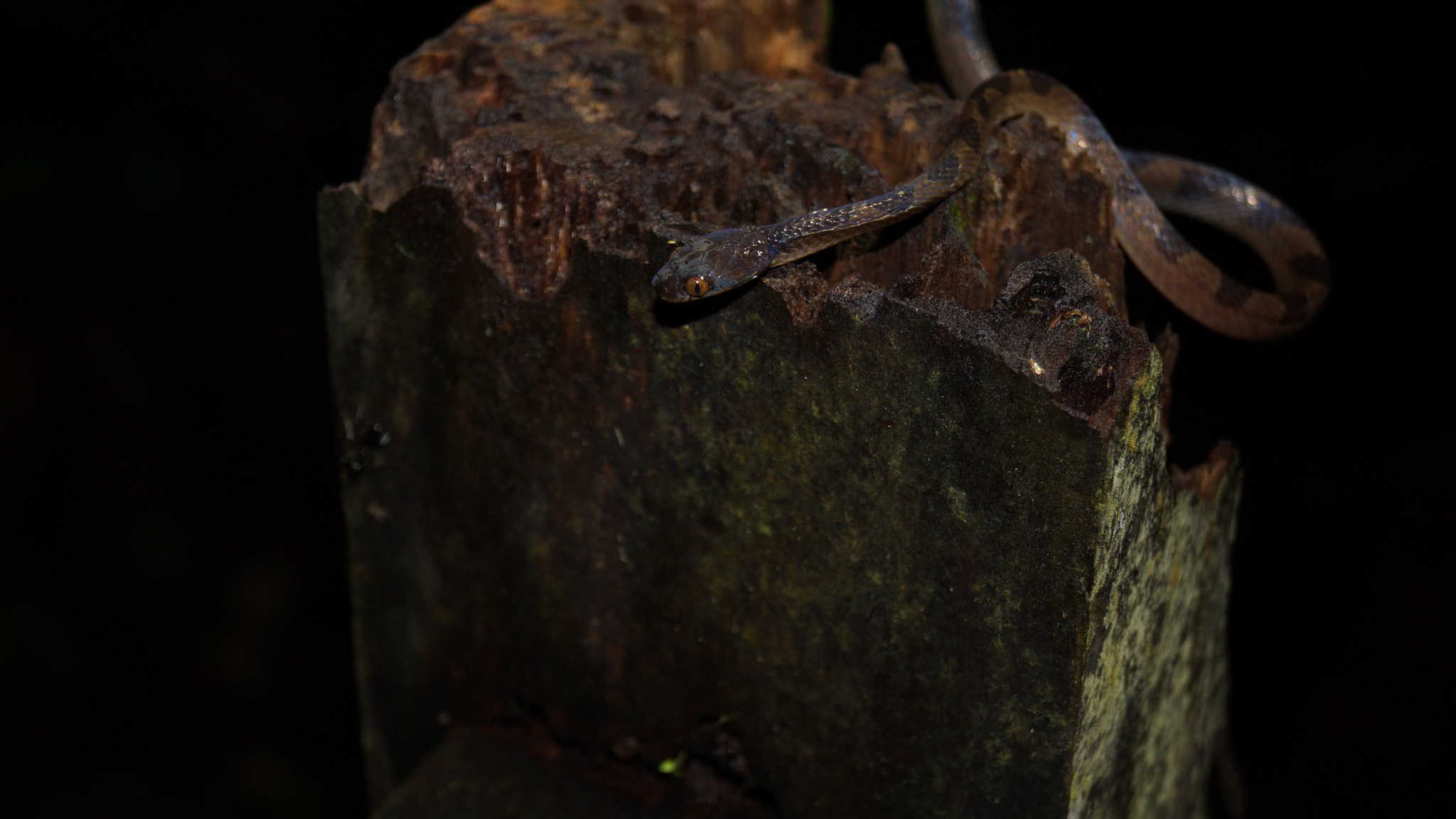
The first detailed bite report came in April 2018. It took place in La Guajira department, Colombia, when a 29 year old female biologist was trying to catch a Leptodeira annulata measuring 666mm. She was bitten on her right index finger, and the snake stayed attached for 10 seconds before being dislodged.
For 3 minutes, she felt a burning sensation, which faded, but was replaced with throbbing pain. Within ten minutes, itching, pain and swelling was spreading from the wound. At 18 minutes, the swelling spread to her other fingers. The biologist rubbed a chunk of ice on the fang marks, but to no avail. The maximum extent of swelling was reached at 40 minutes, covering the entire hand and fingers, which she lost all control over.
The biologist arrived at hospital after 95 minutes, and experienced no systemic symptoms like nausea, weakness or vomiting. It took 5 days for the swelling to fully deflate, and the pain lasted for 8 days. This is a snake of mainly local symptoms, but still capable of inflating your hand like balloon.
| 5 | Active immediately after sunset |
In a study from Brazil, scientists gathered technical habitat data on this snake for the first time. The expedition took place from February-May 2005, and again in July. The scientists searched for 7 days each month, from 18:00 to 0:00. The location was Mato Grosso do Sul state, western Brazil. Rather than rainforest, this is the Pantanal country, a sweeping area of wetland covering 140,000 km², which encompasses a mosaic of ponds, marshes, swamps, and seasonally flooded grassland. Yellow anacondas are a particularly common snake species in the Pantanal.
The scientists found 19 annulated cat-eyed snakes over the study, 10 female and 9 male. Most were reobserved multiple times. Most importantly, only 3% of detections were on the ground. This is a tree snake through and through.
They even narrowed down the favourite trees. L. annulata was spotted in acuri palms 63% of the time, and fig trees 23% of the time. The reason was that acuri palms have greater nooks and crannies where cat-eyed snakes can stash themselves. Rather than coil around branches, exposed to predators, Leptodeira annulata love to stash themselves in dark holes in trunks. At 18:30 each day, they were observed poking their heads curiously from these holes, ready for the evening’s entertainment. The scientists discovered that 19:30-22:30 was their most active period.
| 6 | Eaten by tarantulas! |
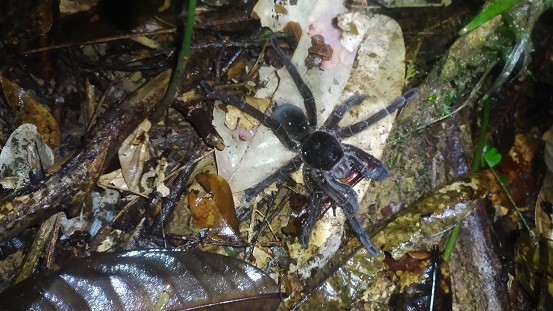
Theraphosa blondi is one of the freakiest tarantulas in nature. It’s called the “goliath birdeater” and when threatened, will rub its back legs over its abdomen, to release hair strands lined with stinging barbs, that cause unbearable pain in enemies. Goliath birdeaters span an entire foot (30cm), and were named after a sighting of one devouring a common scale-backed antbird.
In 2018, scientists were wandering around Pará state in northern Brazil, when they saw this tarantula with an annulated catsnake trapped in its front appendages. The scientists tried to approach, but the tarantula became aggressive and started releasing its piercing hairs, rubbing its abdomen. After 5 minutes, it scuttled away with the catsnake still in its clutches.
Another freaky relationship is with ants. Atta columbica is a leaf-cutter species which carries vegetation and twigs back to its base, only to grow them into a fungus garden, which the colony feeds on. In a 2009 study, scientists discovered 5 eggs in one of these fungus gardens. 2 hatched, and out came baby annulated cat-eyed snakes. The two may have a secret symbiotic relationship. It also means that adult Leptodeira annulata are able to enter leafcutter ant colonies without being assaulted.
| 7 | Destroys muscle tissue |
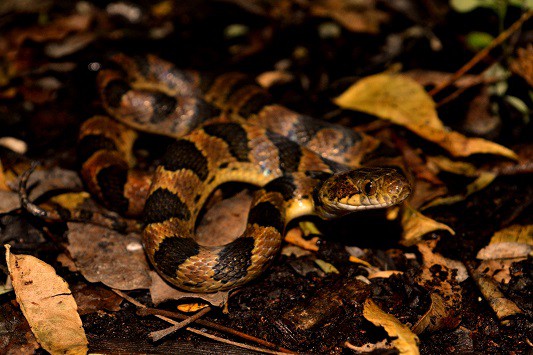
A 2016 study analysed annulated cat-eyed snake venom in mice and chicks. The victims had symptoms resembling a neuromuscular blockade, such as weak muscles which no longer twitched in response to stimuli. However, investigation revealed little neurotoxic effects. The nicotinic acid receptors in muscle cells had no signs of being blocked, as with the post-synaptic neurotoxins found in black mambas.
Instead, the “neurotoxic” effects were caused by the sheer destruction of muscle tissue. The venom had a highly proteolytic activity, and under a microscope, muscle tissue was visibly distorted. Smaller fibres were destroyed, while others were rounded and clearly swollen. The effects on muscle tissue were much stronger in bird tissue than mammal.
The effects were highly concentration dependent. Low amounts of venom barely affected the twitching of muscles, while higher levels reduced it enough to mimic a neurotoxic snake. Other effects on muscles included the widening of intercellular spaces and the direct rupture of muscle cells. The venom was discovered to be low in PLA2s, the main toxin class in coral snakes. Its main class was metalloproteinases. This was proven when scientists used a metalloprotease inhibitor and completely neutered the dangers.
| 8 | Eats mostly frogs, a few reptiles |
A 2008 study analysed the annulated catsnake’s diet, and the results matched with what people had suspected for decades. 260 snakes were gathered from midwestern and southeastern Brazil. In these they discovered 22 prey items, from 17 snakes, with one snake having 3 prey still its belly, and three having 2. The results were clear, as frogs and toads made up 77% of prey.
One tropical house gecko (Hemidactylus mabouia) was found, plus some beetles and plant materials, which were probably ingested accidentally. Last were two snakes, the harmless Atractus zebrinus and the slightly venomous Oxyrhopus guibei. Annulated catsnakes have clear favourites in their diet, but aren’t so strict that they corner themselves into a narrow niche. The one food group they skip is mammals. The likes of rice rats have never been recorded in their diet.
Meanwhile, Leptodeira annulata is swallowed itself by bigger, meaner snakes. In one study, an 80cm Leptodeira annulata was pulled from the stomach of a common lancehead, South America’s most widespread venomous snake, and the top cause of snakebite in the Amazon rainforest.
| 9 | Seizes frogs by the leg |
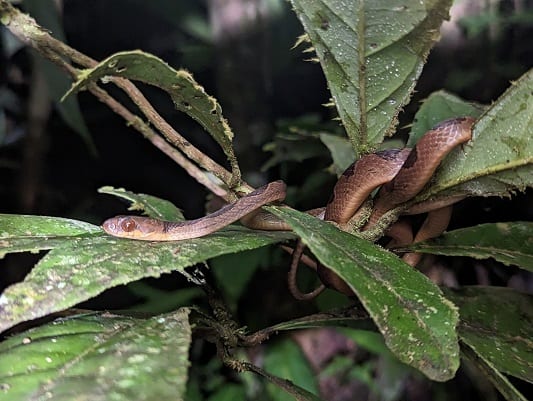
Apparently, Leptodeira annulata is poor at coping with large prey. In 2009, one was observed grabbing a bulky Cei’s white-lipped frog by a pond shore. It grabbed its hind leg, and the two wrestled for 15 minutes. The snake even wrapped its lower body around vegetation to form an anchor, for added leverage. Eventually, the frog burst free, and the annulated catsnake lost its prize.
Though crafty and nimble, this is far from an infallible hunter. The frog measured 80mm, and an older study on 66 Leptodeira annulata found they far preferred small frogs, with an average length of just 29.9mm. The black mamba is another species that mainly eats small prey, averaging at 4% of its body weight.
Another diet study took place in eastern Brazil. Despite being hundreds of miles away, its diet was no different. 44 cat-eyed snakes yielded 51 prey, and all but one were frogs and toads, making for a percentage of 98.03%. The exception was a tropical house gecko. Scientists also found that 28/30 of prey were swallowed headfirst, for those which they could determine the direction of.
| 10 | A patient hunter |
Another event took place in Goiás state, Brazil in 2016. The prey was the common frog Physalaemus cuvieri, a previously confirmed staple in their diet. The Leptodeira annulata silently approached, and like before, its first move was to seize the frog’s right hind leg. This snake seems to be a cunning leg grabber, instinctively targeting a frog’s weak point.
The frog tried furiously to break free, but the catsnake just stayed still. It was obviously waiting for the frog to tire itself. After 7 minutes, the frog made another jailbreak attempt, and accidentally overturned itself and landed on its back.
This was the opening the Leptodeira annulata required, and it commenced swallowing its prey’s legs. Then the frog inflated its body like a balloon. Instead of flying into a rage, the catsnake remained calm, and waited patiently until the frog deflated. Then it completed swallowing, which took 20 minutes from start to finish.
